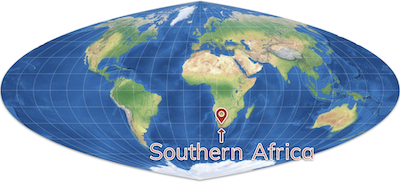
what not to miss & tips
who, why, when, where, what
brief introduction to Southern Africa
GPS (if possible satellite communicator), maps (don't miss specific maps of the parks, showing internal tracks), a good camera (not mobile phone!!), good telephoto lenses (preferably up to 300 mm - 400 mm focal length), safari garments (fresh and light colors) but also trekking boots & layers garments (there are a lot of wonderful mountain trails to hike and explore), trekking backpack, sun protection and sunglasses, bandana for head and neck, insect repellent, 4x4 vehicle with low gears (preferably with diff-lock) with fuel can and additional spare tyre. Don't miss antimalarial prophylaxis if required.
Always inform your hotel / lodge reception when you leave for a trip in lonely and remote areas.
Don't go to the mountains, marshes and / or remote areas without checking the weather conditions are very good. Also check / pay attention eventual alerts by authorities and rangers. Always ask about possible dangers comining from wildlife living in the area you are going to visit.
Please try to be as much informed as possible about need of antimalarial prophylaxis in specific area you are visiting or traveling through. Prophylaxis is useless to do it if you are in a safe area / period, but if you are in an area where there is even a remote chance of malaria, doing the prophylaxis means you may enjoy your journey in a more relaxed way. Final decision it's up to you, but before taking decision, please try to be properly knowledged by collecting informations by your reference doctor, your lodge and local authorities.
Don't go in remote areas alone without having good knowledge of the area, without proper gears, GPS and maps and mostly don't go without a safety / emergency plan you can put in place in case of accident or emergency. Bring always with you sufficient and additional water, food, fuel and warm clothes, as temperatures can be cool at night. Good knowledge of the area means you have to study and spend time in your homework, to plan your trip and to fix a track, to know details, conditions and risks of the place you are are going to visit. This is a wonderful part of your journey and it starts much in advance than travel itself. Don't go there as a weekender tourist! You won't enjoy and you will expose your own life to a big risk.
Pay attention to your valuable goods and keep your passport always with you and an additional copy in a safe place.
Please be as much respectful as possible of places you visit, animals and people who live there
Don't engage yourselves into anything which could be less than 110% safe about risks coming from wildlife. Wildlife is wonderful, you will be astonished about that, but don't forget you will find yourselves visiting home of wild animals; therefore don't disturb them at all and stay at proper distance. Full respect is the main rule. Never forget.
Don't jump off your vehicle when you are travelling into wildlife area with wild animals roaming freely. Never and for no reason at all. Before entering in a wildlife area or park, please collect all the instructions and ask to park rangers at entrance gate the rules, safety policy and suggestions how to enjoy your visit. Several times you will find at entrance gates or at the park camps inside the parks boards reporting notice of wildlife sightings of the day. This is useful for a good safari plan, as it helps to fix proper detours from your main track.
Keep a low profile, friendly but very deferential at any border post. As suggestion, don't display your valuable goods, such big cameras, jewels, fashion sungless and watches, etc. They may sound very attractive for a lot of people. This is valid at border post but mostly valid everywhere in general.
If you cross the borders with your vehicle, don't forget to ask to your rental car station to release to you the documentation for your rental car export/import through various Countries you will visit. Missing this, you will be prevented to cross the borders and your trip will be over.
Respect the rules in full, without objections. Don't ever think to be in a place where you can do things by shortcuts. This is valid for natural stuffs and for authorities' rules.
Generally speaking the first suggestion which works well is try to get noticed as less as possible. This will help you to be safe in human society and to get enjoy wildlife taking amazing photos.
People is very friendly and you are supposed to be the be same with them, but please never drop your attention. Don't engage yourselves into low guard relationships if you don't know very well who you are talking / dealing with.
Last, but the most important thing, never forget these are natural places extremely fragile and endangered. You are a visitor. Do your best to leave such places as they are and bring with you only wonderful memories in your hearth, mind and camera.
Be hungry for adventure, with open mind, wide sense of travel and big, huge love for Nature. Please check to have this within yourself. Then, just fall in love with Southern Africa.
Who: do you love pure nature and wildlife? do you love wilderness and adventure? do you enjoy the taste of life in every moment? let's take a map and draw a track over it, Southern Africa is there waiting for you.
Why: everytime it's difficult to explain the firtst main reason why Souther Africa is addictive. We can say wildlife, the endless landscape of the savannah, the wilderness mountains and ocean coasts, the pristine lands. Actually it's a place where simply people greet you and ask you how you are doing. Always. Actually it's a place where you remain stuck crying admiring the sunset. Actually it's a place where you forget everything else, but the spirit of Nature and you are thrilled to embark in the next adventure every dawn. It's a place where you discover by yourself the meaning of the sentence "Mal d'Africa" / "Mal d'Afrique".
When: preferably in winter, which is the dry season, therefore from late April to late September. As this is a huge area it's striclty depending from specific places you are going to visit, but general rule is that in such period you should avoid rains, mosquitos and enjoy abundant wildlife gathering at the waterholes and rivers for water. This is perfect for amazing safaris and nice trekkings.
Where: if we should pick up just few top places to stay to enjoy this magic huge area are Sesriem (to visit Namib desert area), Etosha to visit the wonderful wildlife park, Shorobe / Maun to visit Okawango delta, Kasane to visit Chobe, Springbok and Calvinia to visit Namaqualand, Franschhoek to visit Cape Winelands, Hout Bay to visit Western Cape and Table mountain, St. Lucia to visit iSimangaliso, Clarens to visit Drakensberg, Phalaborwa / Hoedspruit / Marloth to visit Kruger. Sabi Sand Game Reserve to experience the ultimate safari experience.
What: you can span from far west on Namib dunes, where you can hike into a fairy world, to far east in Kruger where you will be into the realm of wildlife. Everything in the middle is astonishing as well: Naukluft mountains, Western Cape Peninsula, Namaqualand, Fish River Canyon, Etosha, Kalahari, Okawango delta, Chobe and Boteti rivers, Makgakigadi Pans, Victoria Falls, Drakensberg mountains, and many many others stunning places.
brief introduction to southern Africa
It is not easy to start talking about southern Africa without doing it in the most conventional way for the common sense, starting with wildlife; as the wildlife in these places is truly shocking and far beyond any Western visitor's imagination.
Before talking about this wonder, however, it is necessary to correct the stereotype that identifies a trip to Africa with a safari. Southern part of Africa offers an incredible amount of wonders, extraordinary places, protected natural paradises, but also delicate and at risk, still unknown beauties and above all the ability to make simple, but extraordinary, essential details, which before visiting these places we have considered trivial and ordinary.
Southern Africa is fantastic as such; with its ability to give you emotions that pierce your soul, it enters you and occupies a huge place in your way of being, of thinking, of interpreting nature and the world.
Among its ugliness are its contradictions and the horrors of history, but there are also its poverty and the precariousness of life which are a difficult part but which has preserved some natural paradises. Today in these places a lot is being done to improve the living conditions of the people, considering the protection of Nature as a primary resource and a fundamental step. In the West we should learn a lot from this.
There is a lot, a lot to learn by traveling in southern Africa. History first, but then, above all, the great circus of life, the laws of Nature and the boundless love necessary for small, big things.
The first thing to talk about about Southern Africa? The setting sun. The rising sun. Getting excited in a boundless and uncontrolled way in front of this. Without understanding, apparently, the reason. You don't understand it with the rational mind of our Western culture, but then you learn to understand that this emotion that overwhelms you is having discovered that you are a natural being, that you instinctively understand your ancestral origin. It is an archetype, difficult to explain otherwise, but simple to understand if you travel to these places with the right disposition of mind.
Having said this, we can tell you that a trip to Africa will give you unforgettable experiences: the charm of luxury and hospitality of yesteryears is perfectly intertwined with fairytale landscapes, to be discovered with off-road routes and epic trekking; the refined relaxation of a perfect sundowner will be the perfect completion of a safari where you will leave at dawn thrilled to capture wildlife scenes, for which you will resist for a whole day with patience and excitement in the scorching sun.
Whether you find yourself climbing the peaks of the Drakensberg, whether you are going in search of the legendary S100 lions' pride in the Krugrer, whether you will venture into the endless magical dunes of the Namib or face the unrivaled wilderness of the Okawango Delta, you will be always constantly traveling through fantastic places, which will change you forever.
Back home you will feel to be missing a boma, around which you can sit with a glass of wine to admire the stars, enchanted by the exciting pilgrimage of wild animals to waterholes just close to you.
Back to home you will find yourself drawing on your notepaper sketches of iconic acacia trees, Kalahari bush, Naukluft mountains' profiles and Namib dune silohuettes.
The elephants herds approaching Chobe river and the oryxes roaming over the slopes of the Namib will be indelible.
...and we haven't talked about penguis, whales, sharks in the wonderful landscape of Cape Peninsula or about the desert blossoming in the Namaqua or about the wilderness of the Fish River Canyon or about the immensity of Victoria Falls... let's start to open the map and point out your next destination.
Here below a general map of Southern Africa which we have visited during the years and for which we are making tours and photos reportages. (journey including Garden Route and Addo N.P. has been temporary suspended due to Covid-19 outbreak)
For your info, very approximative distances as the crow flies* are:
Johannesburg -> Cape Town = 1200 kms approx
Cape Town -> Windhoek = 1200 kms approx
Windhoek -> Johannesburg = 1200 kms approx
Windhoek -> Okawango Delta = 650 kms approx
Johannesburg -> Kruger N.P. = 350 kms approx
Johannesburg -> Drakensberg Mountains = 270 kms approx
Windhoek -> Namib (Sossusvlei) = 320 kms approx
Windhoek -> Etosha = 380 kms approx
Windhoek -> Fish River Canyon = 570 kms approx
Cape Town -> Namaqua N.P. = 470 kms approx
Cape Town -> Augrabies Falls N.P. = 620 kms approx
Caper Town -> Kgalagadi T.P. = 870 kms approx
Johannesburg -> iSimangaliso W.P. = 480 kms approx
* the above are approximative distances as the crow flies, therefore please allow much greater distances to be travelled by car


 Amazing and powerful spirit
Amazing and powerful spirit 


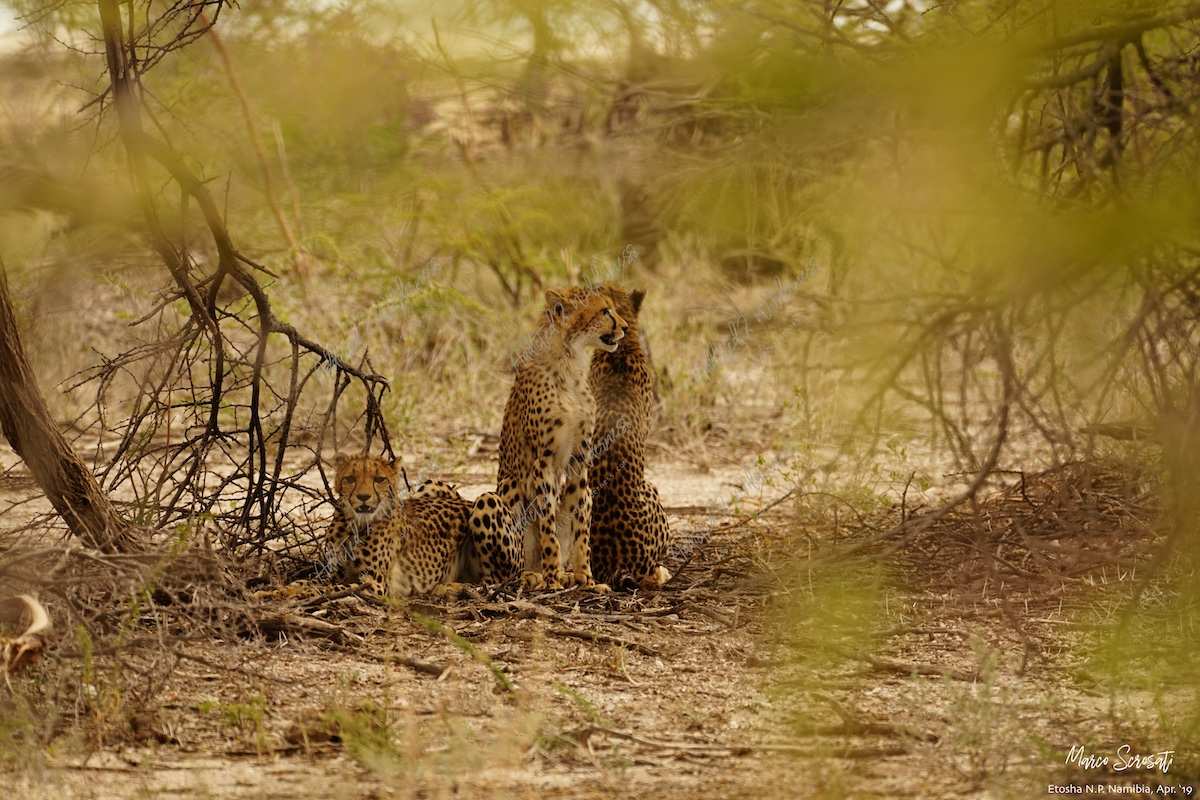

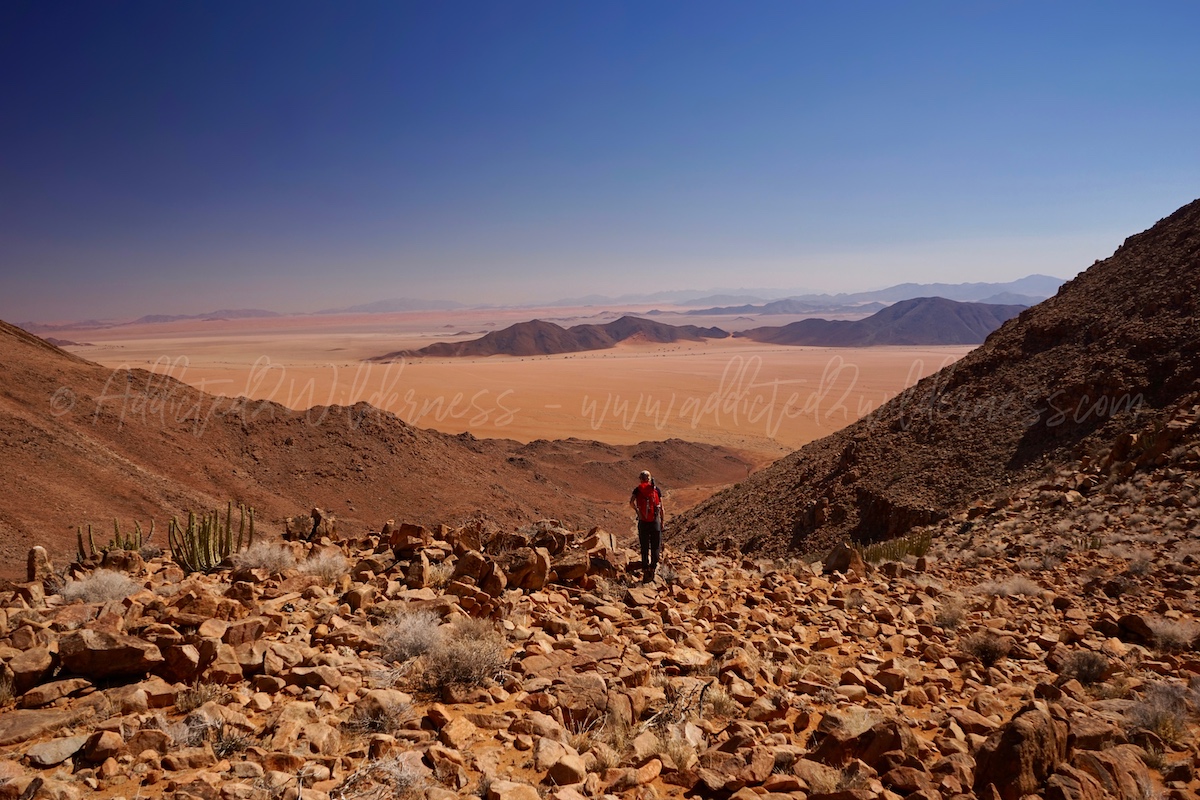
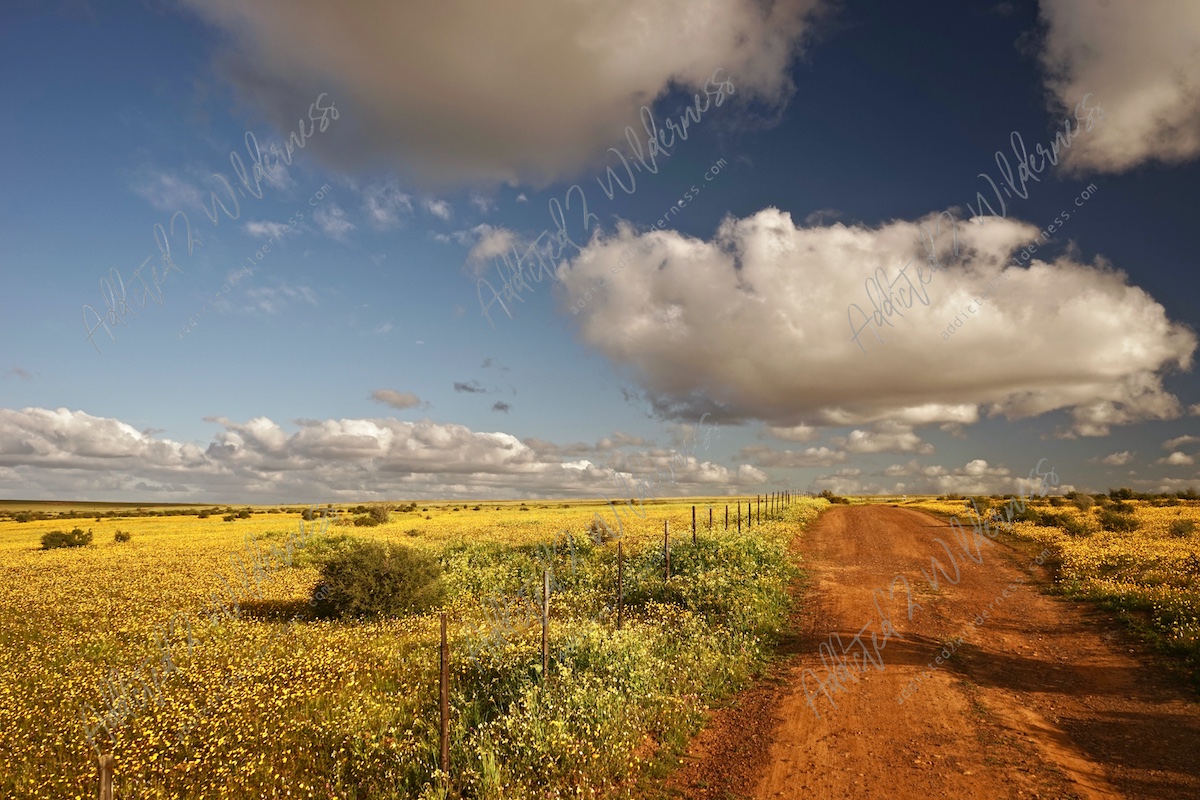
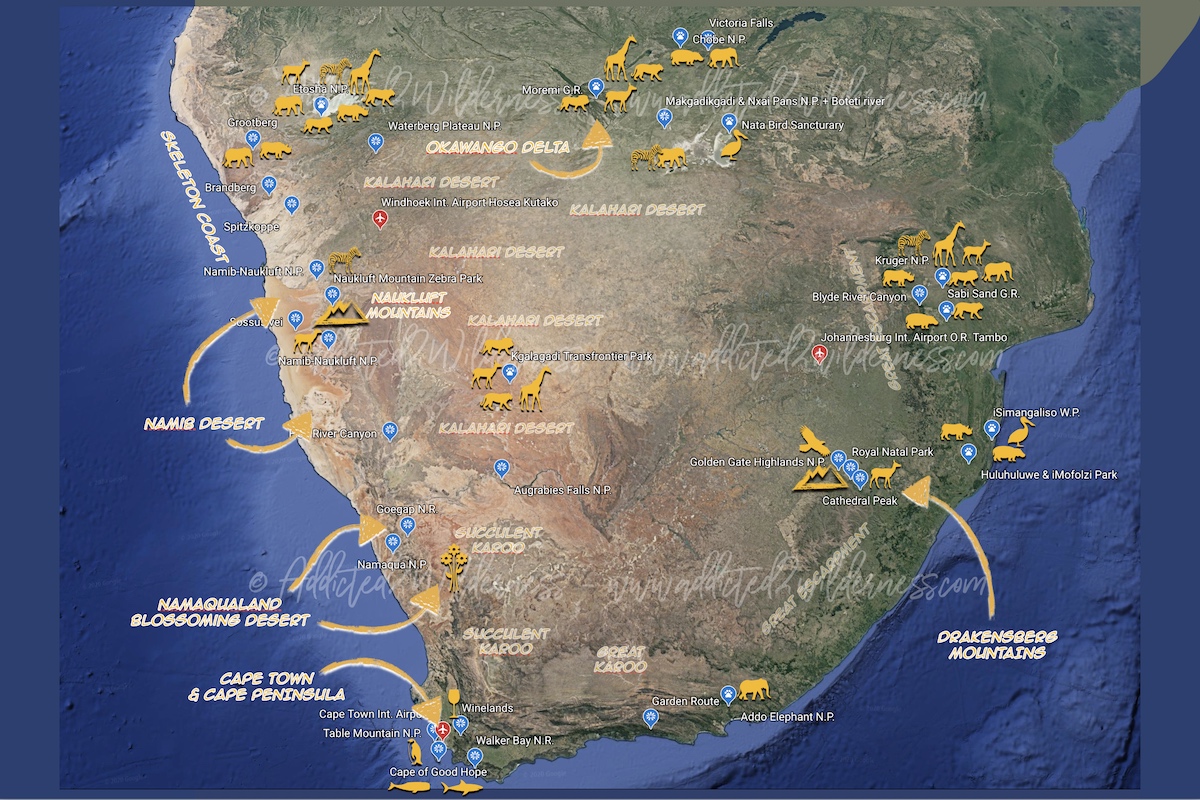
Comments
Love to see pics of them,makes me amazed
Really looking forward to next new world
From Sammy